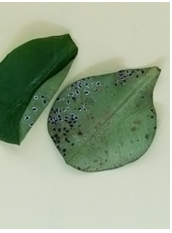
When is a scale insect not a scale insect? When it’s actually the juvenile stage of a whitefly.
That is what some of the local landscapers found out while scouting for pests. The pupal cases of both Tetraleurodes (e.g., mulberry whitefly) and Aleurotrachelus (e.g., pepper whitefly) species are black, surrounded by white filamentous tissue (pictured here), and closely resemble the juvenile stages of the tuliptree scale Toumeyella liriodendri.
Misidentification Melee
To add to the misidentification melee, black-and-white whitefly pupal cases also closely resemble the Cerataphis brasiliensis palm aphid. Key points for distinguishing the differences:
- as with all aphids, the presence of Cerataphis species is accompanied by copious amounts of honeydew and telltale sooty mold;
- Cerataphis infestations occur primarily on new growth/unfurling fronds; and
- C. brasiliensis has only been identified on palms, although C. orchidearum affects orchids. The presence of the tuliptree scale T. liriodendri will also be accompanied by honeydew and sooty mold; and T. liriodendri primarily affects plants in the magnolia family.
Bottom line
If it looks like a scale insect or an aphid infestation but there are no signs of honeydew/sooty mold, think again. It just might not be scale!
Learn more:
 0
0
